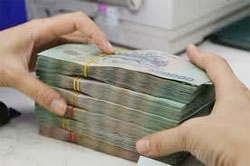Credit limit reshuffled
 |
| illustration photo |
Le Minh Hung, vice governor of State Bank of Vietnam (SBV), last week told the high-profile Vietnam Business Forum that the central bank would apply different credit growth caps in 2012 based on individual banks’ health.
The move means more credit growth will be given to banks with stronger balance sheets and better governance.
It also indicates that SBV is to be more refined in how it applies its credit growth policy as inflation starts to drop, the currency market stabilises and the trade deficit narrows. Previously, some foreign bankers voiced concerns that the application of a single growth rate to all banks rewarded size, but not quality.
They said credit growth should be allocated to banks best able to use it productively for the economy, based on criteria such as capital adequacy, non-performing loan ratios and lending to productive parts of the economy.
The 20 per cent credit expansion cap for 2011 is especially problematic for foreign banks with ambitions to grow their balance sheets. Many foreign bankers complained that they brought in capital at the end of 2010 to adhere to minimum capital rules and single borrower limits, just as credit growth constraints removed their ability to employ the capital productively.
The one-size-fits-all policy means “larger banks are favoured and small banks are panalised,” said Louis Taylor, CEO of Standard Chartered Bank Vietnam and head of the VBF’s banking working group.
Standard Chartered, in the middle of 2011, together with 11 other foreign banks unsuccessfully wrote to the former SBV governor Nguyen Van Giau proposing it to allow them to exceed the 20 per cent cap.
According to SBV, at that time, 12 foreign banks had exceeded the whole-year 20 per cent lending cap. The average January-April credit growth of foreign banks in Vietnam was as high as 14.7 per cent, or more than double the figure of the banking system as a whole.
The tallies meant many foreign banks had little credit expansion space to maneuver in the remaining eight months of the year. Hung said the banking system’s ceiling credit growth rate in 2012 might be set at around 15-17 per cent. “In 2012, SBV will execute a monetary policy which assists the government’s pursuit of single-digit inflation.”
The banking system’s credit growth year-to-date is around 12-13 per cent which is expected to rise to 15 per cent by the year’s end. Many domestic entrepreneurs have complained that the 15 per cent credit expansion was too low compared with the government’s 20 per cent cap which means credit had been too much squeezed.
In response, at the recent National Assembly meeting, SBV governor Nguyen Van Binh argued that if credit growth had reached 20 per cent this year, inflation for the whole year would have been 25-26 per cent, not 18-19 per cent as now estimated.
Vietnam has grown credit at the fastest rate among all Asian economies since 2008, but generates the lowest returns in terms of economic growth from the credit expansion, according to a Credit Suisse report “Vietnam Market Strategy” dated August 29, 2011.
What the stars mean:
★ Poor ★ ★ Promising ★★★ Good ★★★★ Very good ★★★★★ Exceptional
Related Contents
Latest News
More News
- Solid finish for manufacturing after volatile year (January 06, 2026 | 08:50)
- Meiko strengthens Vietnam operations with new PCB plants (January 06, 2026 | 08:49)
- Ho Chi Minh City backs $2 billion AI data centre with dedicated task force (January 06, 2026 | 08:43)
- PM sets January deadline for high-speed rail consultant (January 06, 2026 | 08:40)
- New decree spurs on PPP implementation (December 31, 2025 | 19:01)
- Global alliance develops $1 billion AI data centre network in Vietnam (December 30, 2025 | 10:08)
- Standing out in the Chinese outbound investment wave (December 29, 2025 | 10:29)
- Bright spots obvious in foreign investment mission (December 29, 2025 | 09:00)
- Ho Chi Minh City hits $8.37 billion in FDI (December 29, 2025 | 08:28)
- Vietnam and UK cooperation backs finance talent for IFCs (December 27, 2025 | 16:31)

 Tag:
Tag:





















 Mobile Version
Mobile Version